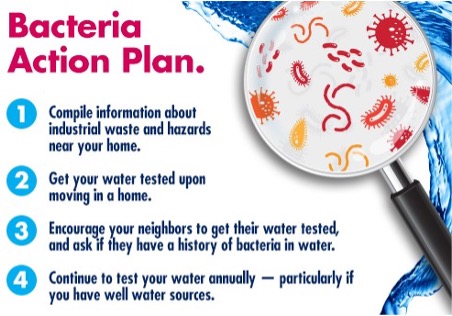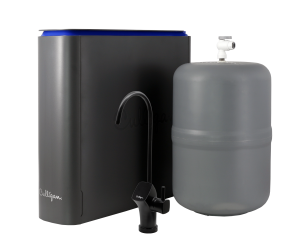Is There Bacteria In Your Well Water?
Bacteria is present in nearly all freshwater sources. Whether you have a private well or spring, or municipal water, most of these contaminants are successfully eliminated and disinfected using chlorination, chloramines or UV treatment. So when should you be concerned?
A number of issues can arise that allow bacteria and viruses to infiltrate your water supply, including runoff, septic systems, animals and poor well/spring construction. If you recently bought a home with a well or spring, get it tested immediately if this wasn’t a requirement over the inspection period.
How To Detect Bacteria In Water
Turbidity is the apt descriptor of cloudy water with suspended solids. While the water itself is not harmful to humans, the suspended solids can act as an impediment to the disinfection process and provide an ideal environment for microbial growth.
The best way to tell if there is bacteria in your water is always to have it tested, although there are signs to recognize if you suspect you might have a problem with your water:
- Water begins leaving unusual or heavy staining around fixtures and drains, may be rust colored
- Water takes on an unpleasant (rotten eggs or moldy) smell
- Water is cloudy or discolored
- If your water shows any of these symptoms, stop drinking and using it immediately it and call your local water authority.
Even if your water shows no outward signs of contamination, make it a habit to test your water at least once a year. If you use well water, test it biannually to ensure your supply is safe. You should also schedule a water test any time you do septic repairs or upgrades.

Treatment Options
While some of the common bacteria can be treated by boiling water, like giardia and cryptosporidium, others are more difficult to eliminate from drinking water. In those cases, you’ll want to be sure you’re treating water with a reverse osmosis filtration system to effectively remove problematic bacteria.
To protect yourself and your family from bacteria found in tap water, there are several options to choose from —whether you want filtration just at the kitchen sink, or a whole house of filtered water free from bacteria.
The type of treatment you need can depend on a variety of factors. Another common form of disinfection technology is UV. Culligan’s UV Disinfection System within its whole home UV water purification solution can be added to your filter or softener to eliminate 99.99% of bacteria, viruses, mold and other waterborne contaminants such as protozoa.
Sometimes, positive bacteria tests are a result of one-time contamination and may only require shock chlorination treatment. This requires a coliform bacteria test, followed by a period of retesting over a two- to three-month period. If this does not work, a more permanent solution is in order.
For private springs, shock chlorination rarely works, as water runs through the spring too quickly to contact the chlorine needed to eliminate the bacteria.
Common Types of Bacteria In Water
Total Coliform – Coliform are a naturally-occurring and usually benign bacteria very common in the environment. While not always an indication of a problem in your water, they can signal that other types of coliforms, like fecal coliforms, could be in the supply. Read more below.
Fecal Coliform – As its name might suggest, fecal coliform indicates water has been contaminated by human or animal waste, commonly as a result of heavy runoff near agricultural areas. Fecal coliform contamination can cause stomach issues when in- gested, ranging from mild upset for young and healthy people to more severe symptoms for children, expecting mothers, the elderly, and those who may already be immunocompromised.
E.coli – Having made its share of headlines, E.coli may be the most recognizable bacteria in water. As a form of fecal coliform bacteria, E.coli in water presents the same symptoms and is generally caused the same way (agricultural runoff, septic system malfunction, well or water infrastructure breakdown). Some forms of E.coli can be more serious than general fecal coliforms, especially for vulnerable members of the population.
Legionella – Legionella is also a commonly occurring bacteria. It becomes problematic when it’s aerosolized — or airborne — as it would if you were using legionella contaminated water for an air conditioning unit, or to shower with (where legionella bacteria would form steam that could then be inhaled). Like coliform contamination, legionella contamination typically occurs through breakdowns in water infrastructure and/or during storms, floods, or other periods of increased runoff.
Giardia & Cryptosporidium – Found all over the world, giardia and cryptosporidium are a parasites that cause severe stomach upset when ingested. They are also closely associated with poor sanitation, waste-contaminated, or otherwise untreated water, and can be caused when runoff near agricultural areas exceeds the capacity of water infrastructure and treatment.
Bacteria That Filters Can Not Remove (and What To Do)
Campylobacteriosis is the most common bacterial cause of diarrhea in the U.S, and affects nearly 1% of the population every year, according to the CDC. Salmonella has been known to cause waterborne disease for more than 100 years. These come from the intestines of humans and animals.
These diseases are found in private wells from sewage malfunctions, runoff, and flooding in wells that are shallow, have been bored or dug, or flooded for longer periods of time. There is no filter that has been certified to remove campylobacter or salmonella.
Contact your local state certification officer if your water tests positive for them, and boil your water.
Bacteria can also cause aesthetic issues. Iron-eating bacteria leaves behind waste deposits, causing sludge in your bathroom and kitchen fixtures. It also can react with hydrogen sulfide to cause the rotten egg smell you may be familiar with in your drinking water.
Bacteria is not always a persistent contaminant. It may the issue of a one-time contamination caused by a faulty well cap, new pump installation or surface runoff from heavy rainfall.
The issue can be a seasonal occurrence, as bacteria naturally thrives in warmer environments, all of these issues can be more prevalent in the spring and summer months.
Bacteria in Municipal Systems
While water bacteria are most often an issue affecting those who use well water, it’s not uncommon for municipal supplies to experience occasional issues with bacteria. It can be an issue during periods of heavy rain or runoff, which often impacts reservoirs and existing water treatment infrastructure.
Viruses In Your Water Supply (Coronavirus, In Particular)
With all the precautions being taken to prevent the spread of novel coronavirus thru social distancing, one concern could have been coronavirus in your tap water.
More than one hundred different species of viruses can spread through water that can lead to diseases in humans — including hepatitis, gastroenteritis, meningitis, fever, rash, and conjunctivitis. But viruses, along with bacteria, are high on the regulation hit list for any water treatment plan. This means most bacteria and viruses don’t have a chance to reach your tap.
Furthermore, the CDC posted a bulletin regarding the issue of coronavirus in water:
“The COVID-19 virus has not been detected in drinking water. Conventional water treatment methods that use filtration and disinfection, such as those in most municipal drinking water systems, should remove or inactivate the virus that causes COVID-19.”
Based on this information, the CDC has determined that coronavirus has not been detected in tap water.
Water Treatment for Viruses
It wouldn’t be unprecedented to have a water issue with coronavirus — albeit these problems are typically not related to drinking water. The last major coronavirus outbreak, SARS, was found to be living in contaminated raw sewage for 2 to 14 days.
But the CDC, WHO and EPA cite traditional water treatment methods as a way to get rid of any coronavirus concerns. This would include:
- Chlorination
- Chloramines
- UV Treatment
Finding Viruses In Unregulated Water Sources Such As Well Water
Other sources where treatment is done by private well owners are more susceptible to contamination. But that doesn’t necessarily mean a virus is lurking in your well. While well water can be a source for bacteria to reside if untreated, there are few instances of anecdotal evidence supporting the presence of viruses in private well water.
“Generally, if a virus gets in a well, it’s an extreme situation, like flooding” said Gary Falkengren, a water treatment specialist with Culligan International for nearly three decades.
Solutions
Suggested Products

The Aquasential® Smart Reverse Osmosis Water Filter (RO)
- 7 stages of filtration and 12 filter options
- Certified for reduction of 58 contaminants
- 2-in-1 sediment and carbon filter screens out sediment and particles
- Can alert you and your dealer when service or filter replacements are needed

Aquasential™ Smart High Efficiency Whole House Water Filters
Reduce sediments in your water and contaminants that cause your water to appear, taste, and smell unpleasant. Your system can also lessen the taste and odor of chlorine, and prevent pipe damage and staining from low pH water. Additional customizations include:
- Culligan® Filtr-Cleer® Water Filters – Reduces Sediment Problems
- Culligan® Cullar® Water Filters – Reduces Taste and Odor Problems
- Culligan® Cullneu Water Filters – Reduces Acid Problems

Facebook